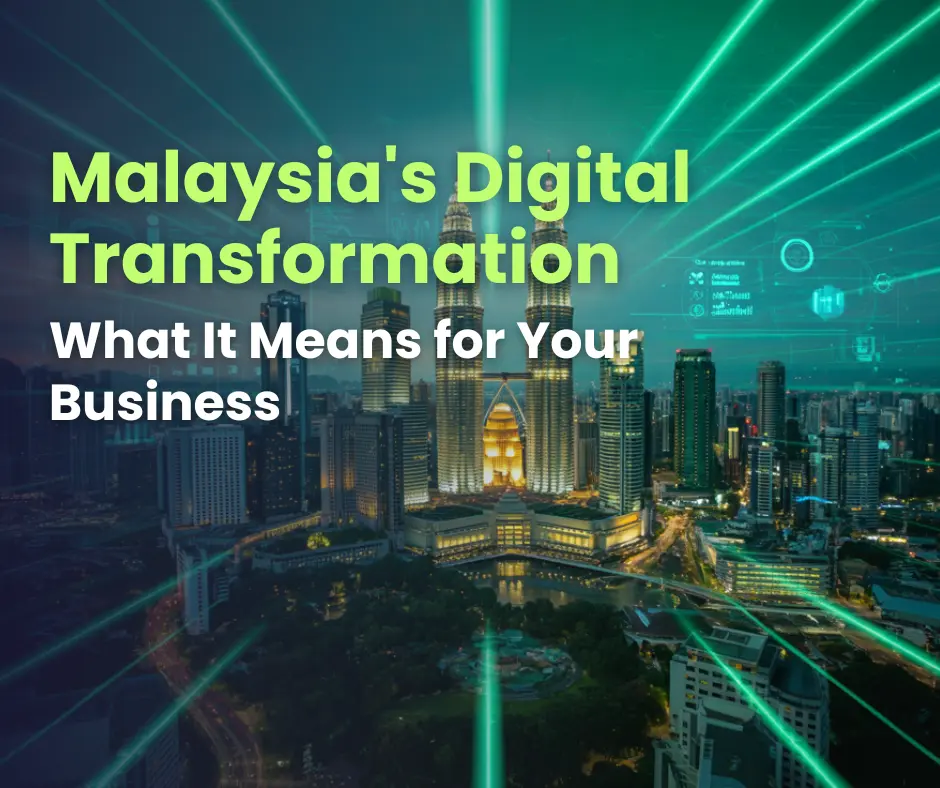
Change is happening across Malaysia. It’s in the way we pay for groceries with our phones, how we access government services online, and the way companies are starting to work. This isn’t random. It’s part of a deliberate, nationwide shift called digital transformation.
For business leaders, this is the new reality of the market. Understanding this shift is essential for staying competitive.
So, what exactly is going on? Let’s break it down.
The National Push: A Blueprint for a Digital Future
The Malaysian government isn’t just watching this happen. It’s actively leading the charge. The centerpiece of this effort is the MyDIGITAL initiative, supported by the broader Thirteenth Malaysia Plan.
Think of MyDIGITAL as the country’s roadmap for becoming a fully digital, data-driven economy. The goals are clear and ambitious: they aim for the digital sector to contribute 22.6% to the national GDP by the end of 2025 and create 500,000 new jobs.
How are they doing it? It comes down to building strong foundations:
- Building Digital Government: Initiatives like the MyGovCloud and the National Digital ID are making public services faster and more secure. The goal is to have most government services available online.
- Sparking Innovation: The government is funding projects through grants, like the 5G Enterprise and AI City Grants. These are designed to encourage businesses to test new technologies in areas like agriculture, healthcare, and education.
- Investing in Infrastructure: The rollout of 5G networks is a priority. Faster and more reliable internet is the backbone that all other digital services run on.
This strong government signal has a powerful effect. It tells every business, from the largest corporation to the smallest SME, which way the wind is blowing.
Big Tech Bets on Malaysia

When global tech giants invest billions, it’s a strong vote of confidence. That’s exactly what’s happening in Malaysia.
- Google, Microsoft, and ByteDance (the company behind TikTok) are all building data centers in the country.
- These investments do more than just create construction jobs. They turn Malaysia into a regional hub for cloud computing and artificial intelligence (AI).
- For local businesses, this means access to world-class digital tools and infrastructure is becoming easier and more affordable than ever.
Where Transformation is Happening Now
This national movement is translating into real-world changes in key industries. Here’s what that looks like on the ground.
Fintech: Changing How We Handle Money
The rise of digital wallets like Touch ‘n Go eWallet and Boost has been rapid. They’ve moved beyond convenience to become a force for financial inclusion, bringing digital payments to people who were previously underserved by traditional banks.
E-Commerce: Smarter Retail
Malaysian e-commerce companies are getting sophisticated. Brands like FashionValet use data analytics to personalize what you see. They also blend online and offline experiences seamlessly, using pop-up events to drive engagement.
Healthtech: Accessible Care
Platforms like DoctorOnCall have made healthcare more accessible. Through telemedicine, people in remote areas can consult a doctor, get a digital prescription, and manage their health without traveling long distances.
Smart Cities: Smarter Living
In places like Cyberjaya and Selangor, companies like TM ONE are implementing Internet of Things (IoT) solutions. This includes smart traffic lights to reduce congestion, intelligent energy grids to save power, and enhanced public safety systems.
Manufacturing: Smarter Factories
Leading manufacturers, such as Hartalega, are embracing Industry 4.0. They integrate robotics, AI, and big data into their production lines. The result is higher-quality products, more efficient processes, and lower operational costs.
The Real-World Challenges

This journey isn’t without its hurdles. Acknowledging them is the first step to overcoming them.
- The Skills Gap: There’s a high demand for people skilled in data analytics, AI, and cybersecurity. While government programs like the Digital Leadership Excellence Programme (DLEP) are helping, this remains a key challenge for many organizations.
- SMEs Need Support: Small and medium-sized enterprises often struggle with the cost and complexity of digital tools. They may lack in-house technical expertise or face internal resistance to changing old habits.
- Cybersecurity Concerns: As we become more digital, we become more vulnerable to cyber threats. Strengthening defenses and complying with data protection laws like the PDPA is a constant priority.
- The Connectivity Divide: Ensuring fast and reliable internet access reaches all parts of the country, including rural areas, is crucial. Without it, the risk of a digital divide increases.
For insights on the specific skills that will matter most, you can explore this perspective on future-proofing your capabilities.
What This Means for You
Malaysia’s digital transformation is not a future concept. It’s here. It’s reshaping customer expectations, creating new competitors, and opening up new ways to operate.
For business owners and executives, this means one thing: adaptation is no longer optional. The businesses that will thrive are the ones that see this change not as a threat, but as the biggest opportunity of the next decade.
The challenge isn’t just about adopting new technology. It’s about understanding how to use it strategically for your specific industry. You need a plan that is practical, focused on your goals, and grounded in real-world business experience.
This is where a clear strategy makes all the difference. If you’re looking to understand how to navigate your own company’s digital shift, a conversation with an expert who has walked this path can be invaluable.
Ready to build a practical AI transformation strategy for your business? Let’s talk. Get in touch with David Hooi here.
Your Digital Transformation Questions, Answered
You might still have some specific questions. Here are answers to a few we haven’t covered yet.
What is the first step for an SME to start with digital transformation?
Don’t try to do everything at once. The best first step is to identify a single, repetitive problem. This could be managing customer inquiries, scheduling social media posts, or tracking expenses.
Find one simple, low-cost tool (like a chatbot, a scheduling app, or cloud-based accounting software) to solve that specific problem. Start small, learn from it, and then build from there.
Is digital transformation only for tech companies?
Not at all. In fact, some of the biggest benefits are for non-tech industries. A restaurant uses digital transformation when it moves from a paper menu to a QR code system and starts managing orders through a cloud-based platform.
A traditional retailer uses it by setting up an e-commerce site. It’s about using technology to improve any business, regardless of the sector.
How long does a typical digital transformation take?
There’s no single timeline. It’s not a project with an end date but an ongoing process of adaptation. You might see results from a small initiative in a few weeks (like automating a report). A larger shift, like changing your entire sales process, could take a year or more.
What’s the difference between “digitalization” and “digital transformation”?
This is a common point of confusion.
- Digitalization is about converting analog information into digital formats. For example, scanning paper invoices into PDFs is digitalization. The process (invoicing) remains the same.
- Digital transformation changes the core business process itself. Using the same example, it would be creating a fully automated, cloud-based invoicing system that integrates with your accounting software and sends automatic payment reminders. It’s a fundamental change in how you operate.
We have an IT department. Isn’t this their job?
This is one of the biggest misconceptions. While your IT team is crucial for implementation, digital transformation is a business strategy, not an IT project. The drive and vision must come from leadership.
You need to define the business goals like improving customer experience or entering new markets and then work with IT to find the right technology to achieve them. It’s a collaborative effort.

